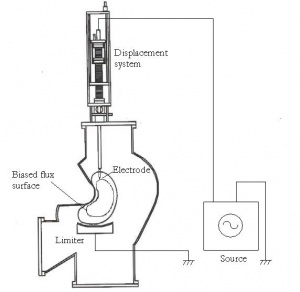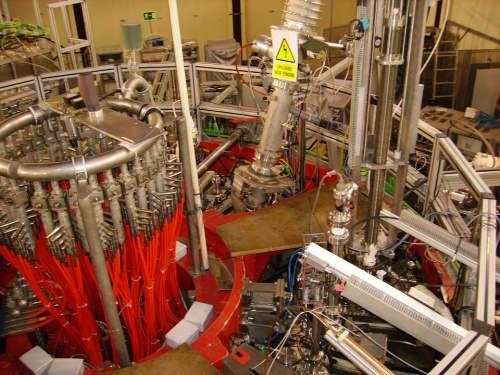TJ-II:Biasing probe: Difference between revisions
No edit summary |
m (Fixed sector reference (toroidal angle is correct)) |
||
| (3 intermediate revisions by one other user not shown) | |||
| Line 1: | Line 1: | ||
[[File:TJ-II_Biasing_probe.jpg|300px|thumb|right|Layout of the biasing probe, mounted on the [[TJ-II:Langmuir Probes|reciprocating probe]] drive]] | [[File:TJ-II_Biasing_probe.jpg|300px|thumb|right|Layout of the biasing probe, mounted on the [[TJ-II:Langmuir Probes|reciprocating probe]] drive]] | ||
At [[TJ-II]], a 2-D carbon composite mushroom shaped electrode (12 mm high with a diameter of 25 mm) has been developed and installed on a fast reciprocating probe drive. Typically, the electrode is inserted to a position 2 cm inside the last closed flux surface (LCFS) and biased positively (200-300 V) with respect to one of the two [[TJ-II:Limiter|TJ-II limiters]] located in the [[Scrape-Off Layer]] region (about 0.5 cm beyond the LCFS). Measured electrode currents are in the range of 30-50 A. | At [[TJ-II]], a 2-D carbon composite mushroom shaped electrode (12 mm high with a diameter of 25 mm) has been developed and installed on a fast reciprocating probe drive. Typically, the electrode is inserted to a position 2 cm inside the last closed flux surface (LCFS) and biased positively (200-300 V) with respect to one of the two [[TJ-II:Limiter|TJ-II limiters]] located in the [[Scrape-Off Layer]] region (about 0.5 cm beyond the LCFS). Measured electrode currents are in the range of 30-50 A. | ||
<ref> | |||
<ref> | The impact of biasing on confinement properties has been studied to some depth. | ||
<ref>C. Silva et al, ''Transport and fluctuations during electrode biasing on TJ-II'', [[doi:10.1007/s10582-006-0044-3|Czech. J. Phys. '''55''' (2005) 1589]]</ref> | |||
<ref>M.A. Pedrosa et al, ''Transport and fluctuations during electrode biasing experiments on the TJ-II stellarator'', [http://www-pub.iaea.org/MTCD/Meetings/FEC2006/ex_p4-40.pdf Proc. 12<sup>st</sup> Fusion Energy Conf. (2006) EX-P4/40]</ref> | |||
In 2009, the power source (originally DC) has been upgraded to allow modulation with a frequency of up to a few kHz. | In 2009, the power source (originally DC) has been upgraded to allow modulation with a frequency of up to a few kHz. | ||
Location: [[TJ-II:Sectors|sector]] | Location: [[TJ-II:Sectors|sector]] A8 (φ = 174.4 °). | ||
Signal names in the [[TJ-II:Shot_database|TJ-II database]]: | Signal names in the [[TJ-II:Shot_database|TJ-II database]]: | ||
'PolI', 'PolV'. | 'PolI', 'PolV'. | ||
Revision as of 11:09, 1 December 2021

At TJ-II, a 2-D carbon composite mushroom shaped electrode (12 mm high with a diameter of 25 mm) has been developed and installed on a fast reciprocating probe drive. Typically, the electrode is inserted to a position 2 cm inside the last closed flux surface (LCFS) and biased positively (200-300 V) with respect to one of the two TJ-II limiters located in the Scrape-Off Layer region (about 0.5 cm beyond the LCFS). Measured electrode currents are in the range of 30-50 A.
The impact of biasing on confinement properties has been studied to some depth. [1] [2]
In 2009, the power source (originally DC) has been upgraded to allow modulation with a frequency of up to a few kHz.
Location: sector A8 (φ = 174.4 °). Signal names in the TJ-II database: 'PolI', 'PolV'.
References
- ↑ C. Silva et al, Transport and fluctuations during electrode biasing on TJ-II, Czech. J. Phys. 55 (2005) 1589
- ↑ M.A. Pedrosa et al, Transport and fluctuations during electrode biasing experiments on the TJ-II stellarator, Proc. 12st Fusion Energy Conf. (2006) EX-P4/40
